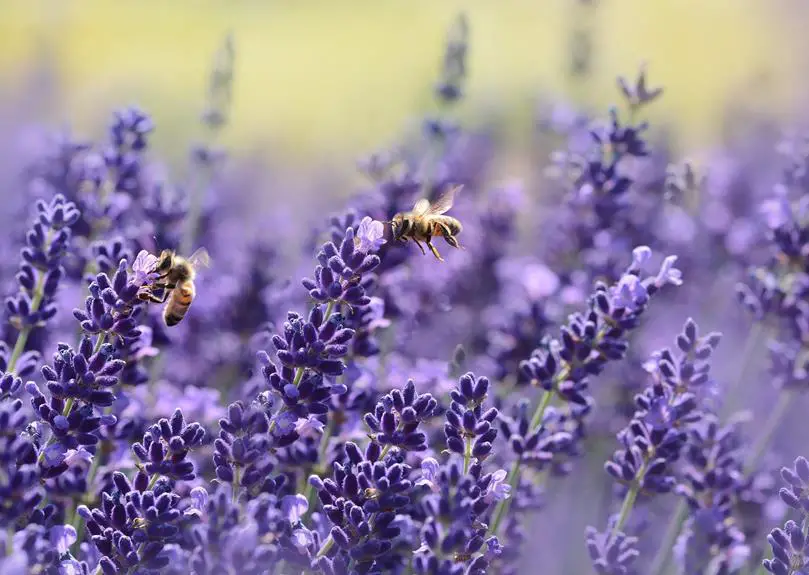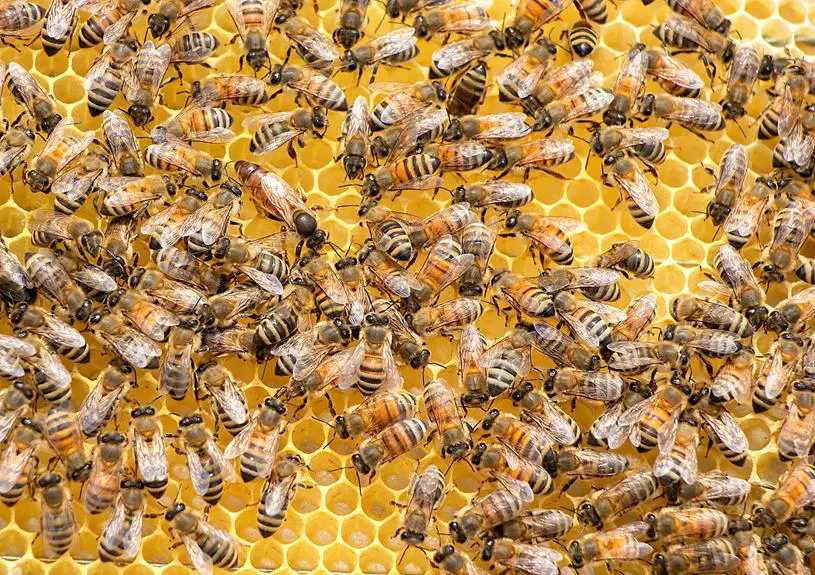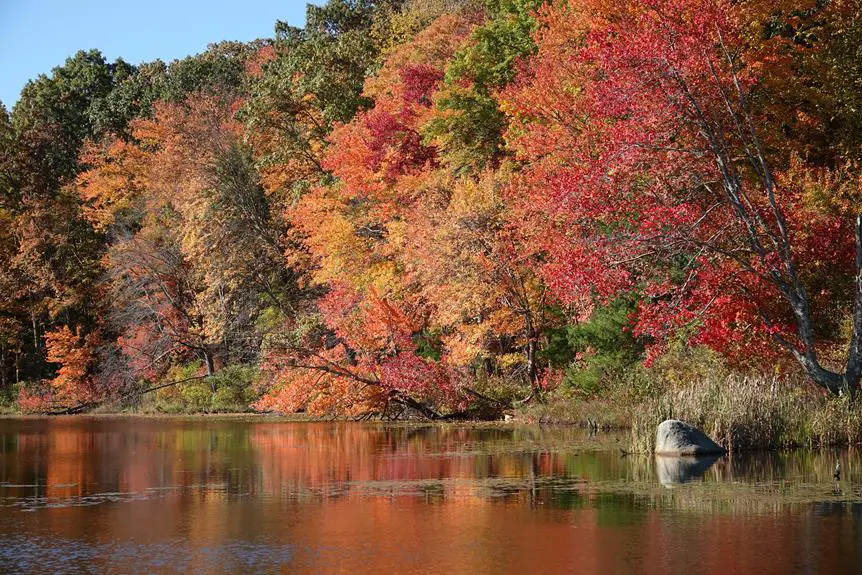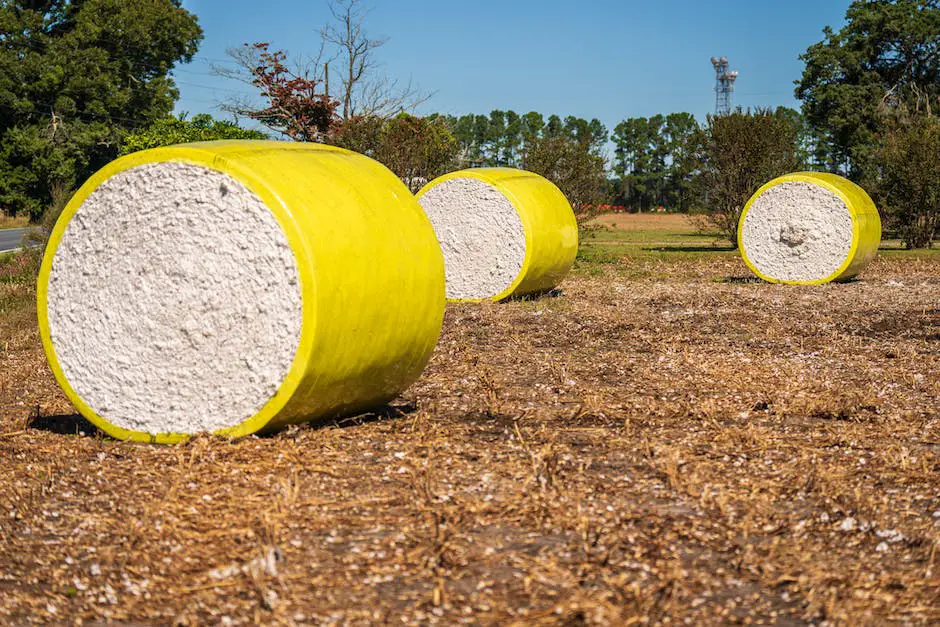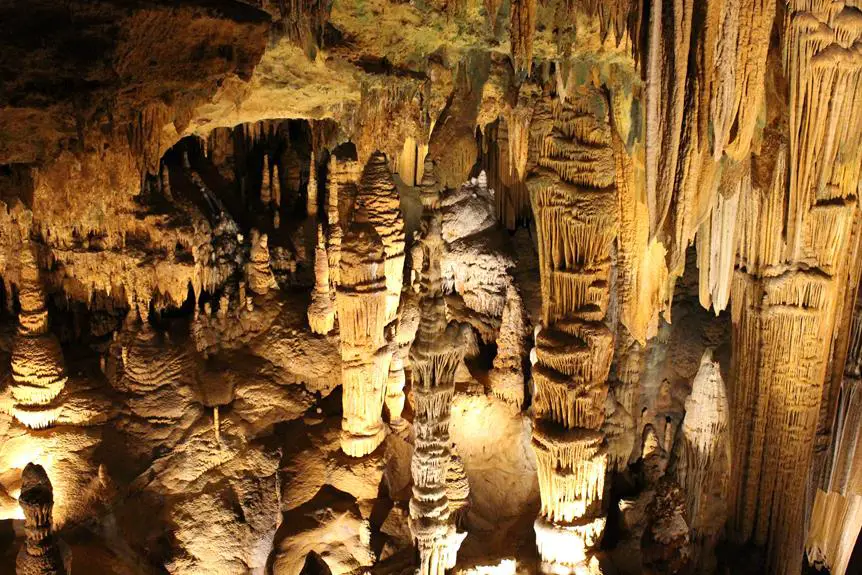In South Carolina, bees play a vital role in the ecosystem. Take, for instance, the honeybee. These industrious insects pollinate flowers, ensuring the reproduction of many plant species.
Alongside the honeybee, there are other bee types found in the region, such as the bumblebee, carpenter bee, sweat bee, leafcutter bee, and mason bee. Each bee species contributes to the intricate web of life, making South Carolina a buzzing haven for these important pollinators.
Key Takeaways
- Honeybees are social insects that communicate through dances and pheromones.
- Bumblebees contribute to pollination and play a vital role in the ecosystem.
- Carpenter bees drill into wood to create nests and exhibit aggressive behavior.
- Leafcutter bees actively forage for leaves, construct intricate nests, and play a crucial role in pollination.
- Mason bees are solitary and create individual nests using mud, protecting their offspring and aiding in pollination.
Honeybee
The honeybee plays a crucial role in South Carolina's ecosystem by pollinating plants and producing honey. Honeybees are social insects that live in highly organized colonies. Each colony consists of a queen bee, worker bees, and male drones. Honeybee behavior is fascinating as they work together in a coordinated manner to ensure the survival of the colony.
One important aspect of honeybee behavior is their communication system. Honeybees communicate with each other through a series of intricate dances known as the waggle dance. This dance conveys information about the location of food sources to other bees in the colony. By performing specific movements and vibrations, the dancing bee is able to indicate the direction and distance of the food source. This communication method allows honeybees to efficiently gather nectar and pollen from flowers, ensuring the pollination of plants in South Carolina.
Additionally, honeybees use pheromones to communicate within the colony. The queen bee releases pheromones that regulate the behavior of the other bees. These chemical signals help maintain colony cohesion and organization. Pheromones also play a role in swarming, a natural behavior where a new queen and a portion of the colony leave the hive to start a new one.
Bumblebee
Bumblebees, another important type of bee in South Carolina, also contribute to the ecosystem through their role in pollination. These fuzzy insects are known for their vibrant colors and unique buzzing sound as they fly from flower to flower. The bumblebee population in South Carolina plays a crucial role in maintaining the balance of the local flora and fauna.
Bumblebees are excellent pollinators due to their ability to extract nectar by vibrating their wings, a process known as buzz pollination. This technique allows them to access the pollen hidden within the flower's anthers, increasing the chances of successful pollination. As a result, bumblebees help in the reproduction of numerous plant species, ensuring the availability of food for other animals and the overall health of the ecosystem.
To conserve the bumblebee population in South Carolina, researchers and conservationists are implementing various strategies. These efforts include creating and maintaining suitable habitats, reducing the use of pesticides, and raising awareness about the importance of these pollinators. By protecting bumblebees, we can safeguard not only their population but also the intricate web of life that relies on their pollination services.
Carpenter Bee
Carpenter bees are known for their unique behavior of drilling into wood to create nesting sites. These bees prefer unpainted and weathered wood, such as fences, decks, and wooden structures.
To prevent carpenter bee infestations, it's important to regularly inspect and maintain wooden surfaces. This includes filling any existing holes and applying paint or sealant to protect the wood.
Carpenter Bee Behavior
While they may resemble bumblebees, carpenter bees in South Carolina exhibit distinct behavior. These bees are known for their aggression when it comes to defending their nests. When threatened, carpenter bees can become highly territorial, buzzing loudly and darting towards the intruder with their stingers raised. This aggressive behavior can be intimidating, especially if one gets too close to their nesting areas.
In terms of mating behavior, male carpenter bees are often seen circling around female bees in an elaborate courtship display. They perform acrobatic flights, emitting loud buzzing sounds to attract the female's attention. Once the female is receptive, mating occurs in mid-air.
After mating, the female carpenter bee will search for suitable wood to create her own nest, where she'll lay her eggs and continue the life cycle of these fascinating insects.
Carpenter Bee Habitats
Carpenter bees in South Carolina commonly establish their habitats within wooden structures. These bees are known for their ability to drill perfectly round holes into wood to create their nests. They prefer untreated or weathered wood, such as fences, decks, and wooden furniture.
The carpenter bee diet consists mainly of nectar and pollen, which they gather from a variety of flowering plants. These bees are important pollinators for many South Carolina plants.
As for their mating habits, male carpenter bees are territorial and will often guard their nesting sites. They'll aggressively defend their territory against other males and potential threats. Female carpenter bees will select a suitable nesting site and lay their eggs in individual chambers within the wood.
Carpenter Bee Prevention
To prevent carpenter bees from establishing their habitats within wooden structures, it's important to take proactive measures. Here are some effective ways to control carpenter bees and prevent their damage:
- Sealing: Seal any cracks or crevices in wooden structures to prevent carpenter bees from finding entry points.
- Painting: Apply a fresh coat of paint to wooden surfaces, as carpenter bees are less likely to burrow into painted wood.
- Repellents: Use natural remedies such as citrus oil or almond oil to deter carpenter bees from nesting in wooden structures.
By implementing these carpenter bee prevention methods, you can protect your property from the destructive habits of these bees.
Remember to regularly inspect your wooden structures and take immediate action if you notice any signs of carpenter bee activity.
Sweat Bee
Sweat bees can be found in South Carolina during the summer months. These bees, also known as halictid bees, are attracted to the salt in human sweat, hence their name. While some people may find their presence annoying, sweat bees play an important role in bee pollination.
Sweat bees are small, metallic-colored insects that range in size from 3 to 10 millimeters. They're commonly seen buzzing around flowers and plants, collecting nectar and pollen. As they visit various flowers, sweat bees unintentionally transfer pollen from the male parts of the flower to the female parts, aiding in the fertilization process. This makes them valuable pollinators for many crops and wildflowers in South Carolina.
Despite their small size, sweat bees are hard workers when it comes to pollination. They visit a wide variety of flowering plants, including fruit trees, vegetables, and native plants. Their efficient pollination services contribute to the growth and reproduction of these plants, ensuring the production of fruits, seeds, and new generations of plants.
Leafcutter Bee
The Leafcutter bee, commonly found in South Carolina, has unique nesting habits that set it apart from other bee species. These bees are known for cutting small pieces of leaves to construct their nest cells, which they seal with a mixture of leaf fragments and saliva.
The lifespan of a Leafcutter bee typically ranges from a few weeks to a few months, during which they play a crucial role in pollinating various plants in the region.
Nesting Habits of Leafcutters
Nesting in preexisting cavities, leafcutters construct their intricate nests using circular pieces of leaves. These industrious bees exhibit fascinating nesting habits that involve specific behaviors and materials.
The nesting habits of leafcutters can be understood through the following points:
- Leafcutter bee foraging behavior: Leafcutters actively forage for leaves, using their sharp mandibles to cut perfectly round discs from various plant species. They carefully select leaves that are suitable for their nesting needs.
- Leafcutter bee nesting materials: Once the leaf discs are collected, the leafcutters transport them back to their nests. Inside the preexisting cavities, they meticulously arrange the leaf pieces, creating a series of cells. Each cell is lined with a waterproof substance secreted by the bees, ensuring protection for their developing offspring.
- Intricate nest construction: Leafcutters carefully stack the leaf discs on top of each other, creating a secure and sturdy structure. This multi-layered nest provides insulation and prevents moisture from entering, maintaining a favorable environment for the growth and development of their young.
Through their unique nesting habits, leafcutters demonstrate their resourcefulness and adaptability, showcasing the impressive capabilities of these remarkable bees.
Leafcutter Bee Lifespan
Discussing the lifespan of the leafcutter bee, it's important to understand its longevity and reproductive capabilities.
Leafcutter bees, like many other bee species, face numerous predators in their environment. Birds, spiders, and certain wasp species are known to prey on leafcutter bees, making their lifespan vulnerable to these threats.
However, leafcutter bees have developed a unique reproductive cycle that helps ensure the survival of their species. The female leafcutter bee creates nests by cutting circular pieces of leaves and lining them with pollen and nectar. She then lays a single egg in each cell and seals it. The larvae hatch and feed on the provisions left by their mother. After a few weeks, they pupate and emerge as adult bees, ready to continue the cycle of life.
Despite the challenges they face from predators, leafcutter bees have adapted remarkable reproductive strategies to maintain their population.
Leafcutter Bee Pollination
As they go about their nesting and reproductive cycle, leafcutter bees play a crucial role in pollination. These industrious bees aren't only responsible for pollinating a variety of flowering plants but also contribute to the growth and production of crops.
Leafcutter bees are particularly important in leafcutter bee farming, where they're managed and utilized for their pollination services. This sustainable agricultural practice involves providing artificial nesting materials and flowers for the bees to forage, resulting in increased crop yields.
Leafcutter bee farming not only benefits farmers but also contributes to leafcutter bee conservation by providing a suitable habitat for these beneficial insects. By supporting leafcutter bee populations, we can ensure the continued pollination of plants and the preservation of biodiversity.
Mason Bee
The mason bee is a solitary bee species found in South Carolina. Unlike honeybees, mason bees don't live in large colonies. Instead, they prefer to live alone and create individual nests.
The life cycle of a mason bee begins when the adult female emerges from her cocoon in the spring. She'll then search for a suitable nesting site, which can be a hollow plant stem or a pre-existing hole in wood. Once she's found a suitable location, the mason bee will begin constructing her nest. Using mud, the female bee will build a series of individual chambers within the nesting site. Each chamber will contain a single egg and a supply of pollen for the developing larva.
After laying her eggs, the female bee will seal off each chamber with mud to protect the developing offspring. The eggs will hatch, and the larva will feed on the pollen until they're ready to pupate. Inside the sealed chamber, the larva will transform into adult bees. Once they've completed their development, the adult bees will emerge from their chambers and repeat the life cycle.
Mason bees are important pollinators in South Carolina, helping to ensure the reproductive success of many plant species.
Frequently Asked Questions
Do All Types of Bees in South Carolina Produce Honey?"
Yes, all types of bees in South Carolina produce honey. However, it's important to note that not all bees are honeybees. Solitary bees also play a role in pollination in South Carolina, and bees can thrive without human intervention.
Are Bumblebees Native to South Carolina?"
Yes, bumblebees are native to South Carolina. They play a crucial role in pollination, ensuring the reproduction of many plants. Their fuzzy bodies collect and spread pollen, making them important contributors to a healthy ecosystem.
Are Carpenter Bees Harmful to Wooden Structures in South Carolina?"
Carpenter bees can be harmful to wooden structures in South Carolina. However, it's important to note that honey bees are declining in the state. Bees in South Carolina provide numerous benefits, including pollination and honey production.
Do Sweat Bees Pose a Threat to Humans in South Carolina?"
Sweat bees, while annoying, do not pose a significant threat to humans in South Carolina. They are attracted to sweat and may sting if provoked. Identifying them can be done by their small size and metallic coloring.
Are Mason Bees Commonly Found in Residential Areas of South Carolina?"
Mason bees are commonly found in residential areas of South Carolina. They are important pollinators and their habitats are being conserved. Efforts are underway to protect and promote these beneficial insects.

